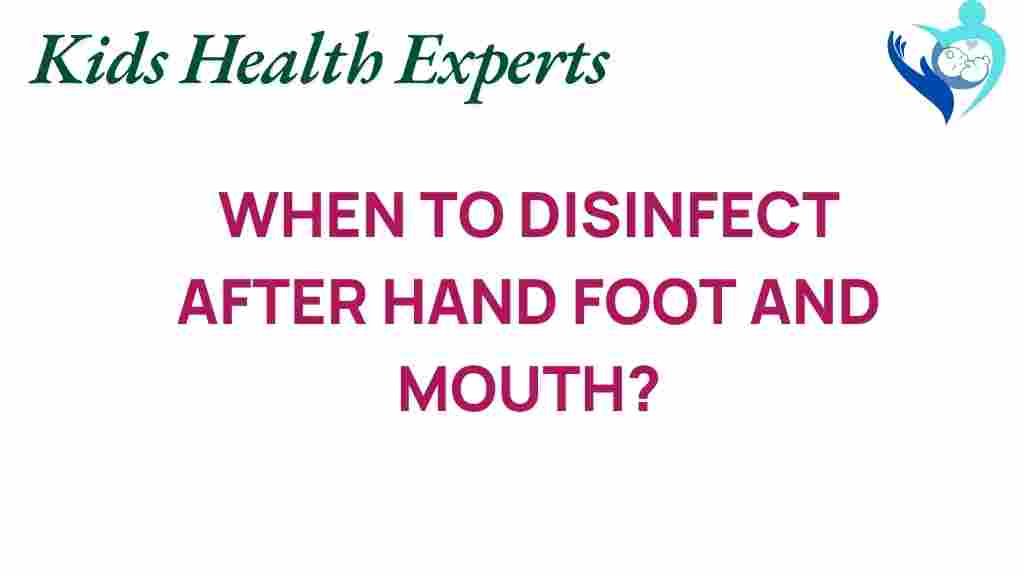When Should You Disinfect After Hand, Foot, and Mouth Disease?
Hand, Foot, and Mouth Disease (HFMD) is a common viral illness mostly affecting young children. Characterized by fever, sores in the mouth, and a rash on the hands and feet, HFMD can spread quickly in childcare settings. Understanding when and how to disinfect after an outbreak is crucial for preventing further spread of the illness and ensuring the health and safety of children. This article will guide you through the best practices for disinfecting after HFMD, focusing on prevention and hygiene.
Understanding Hand, Foot, and Mouth Disease
Before diving into the disinfecting process, it’s essential to understand what Hand, Foot, and Mouth Disease is. Caused by viruses from the Enterovirus genus, HFMD is highly contagious and can easily lead to outbreaks in schools and daycare centers. Symptoms typically appear 3 to 7 days after exposure and may include:
- Fever
- Sore throat
- Painful sores in the mouth
- Rash on the hands and feet
- Irritability in infants and toddlers
Since HFMD primarily affects children under 5 years old, it’s imperative for parents and caregivers to be vigilant about hygiene practices and to know when to disinfect their environment.
When to Disinfect
Disinfecting surfaces and items that may have been contaminated is crucial in managing an outbreak of HFMD. Here’s a step-by-step process for when and how to disinfect effectively:
Step 1: Immediately After Diagnosis
Once a child is diagnosed with Hand, Foot, and Mouth Disease, it’s time to start disinfecting. This includes:
- Cleaning and disinfecting surfaces that the infected child has touched.
- Removing any items like toys, blankets, or utensils that may have come into contact with the child.
Step 2: During the Illness
While the child is symptomatic, continue to maintain a high level of hygiene:
- Encourage frequent handwashing with soap and water for at least 20 seconds.
- Use hand sanitizer with at least 60% alcohol when soap and water are not available.
- Disinfect frequently touched surfaces daily, such as doorknobs, light switches, and countertops.
Step 3: After Symptoms Resolve
Even after symptoms have subsided, the virus can linger on surfaces. Therefore, thorough cleaning and disinfecting should continue:
- Wash all soft toys, bedding, and clothing in hot water.
- Disinfect hard surfaces with an EPA-approved disinfectant effective against enteroviruses.
- Use a steam cleaner on carpets and upholstery where appropriate.
Disinfecting Specific Areas
Different areas of the home may require specific attention. Here’s how to approach disinfecting various spaces:
Living Areas
In shared spaces, such as living rooms and kitchens:
- Wipe down surfaces with a disinfectant spray or wipes.
- Pay special attention to shared items like remote controls, tablets, and kitchen counters.
Bathrooms
Bathrooms are hotspots for germs, so it’s vital to maintain cleanliness:
- Disinfect toilet handles, faucets, and light switches.
- Consider using disposable cleaning cloths to avoid cross-contamination.
Children’s Play Areas
For areas where children play or spend time, such as playrooms or nurseries:
- Clean and disinfect toys, especially those that are frequently mouthed.
- Use a mixture of soap and water followed by a disinfectant on play mats and surfaces.
Preventing HFMD Outbreaks
Aside from disinfecting, there are several preventive measures that can help reduce the risk of Hand, Foot, and Mouth Disease outbreaks:
- Encourage Regular Handwashing: Teach children to wash their hands frequently, especially after using the bathroom and before meals.
- Avoid Close Contact: Keep sick children at home to prevent spreading the virus to others.
- Regularly Clean Common Areas: Implement a routine for cleaning and disinfecting common areas in your home or childcare setting.
Troubleshooting Disinfection Challenges
Sometimes, disinfecting can be challenging, especially in homes with multiple children. Here are some troubleshooting tips:
Inaccessible Surfaces
If certain surfaces are hard to clean, try:
- Using a vacuum cleaner equipped with a HEPA filter to reduce dust and allergens.
- Employing furniture covers that can be easily washed.
Persistent Germs
If you’re concerned about lingering germs, consider:
- Using UV light disinfecting devices, which can help eliminate bacteria and viruses.
- Hiring professional cleaning services for thorough disinfecting if an outbreak is severe.
Conclusion
Hand, Foot, and Mouth Disease can quickly spread, especially among young children. Disinfecting effectively and consistently is key to preventing outbreaks and ensuring the safety and health of your family and community. Remember to maintain good hygiene practices and keep an eye on symptoms in children. For more information on hygiene practices, you can visit the CDC’s official page on Hand, Foot, and Mouth Disease.
By following the steps outlined in this article, you can create a safer environment and reduce the risk of illness. Always prioritize cleaning and disinfecting, and consult with healthcare professionals if you have any concerns about HFMD.
This article is in the category Conditions and created by KidsHealthExperts Team
